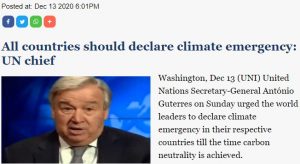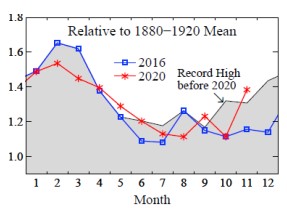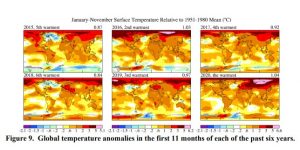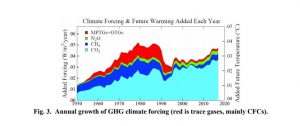2020 will be the hottest year ever recorded AND the rate of global warming accelerated. On December 14, 2020 Dr. James Hansen, former NASA Goddard Space Institute Director, released a new post called “Global Warming Acceleration”. This explanation for the rapid burst of warming may surprise you. Our second guest, Dr. Bjorn Stevens from the Max Planck Institute disagrees in a replay interview.
Listen to or download this Radio Ecoshock show in CD Quality (57 MB) or Lo-Fi (14 MB)
Video of my review of “Global Warming Acceleration” (first 24 minutes of the radio show)
In the radio version, I corrected an error in this video where I say 1 watt = 1 Joule (removed that erroneous statement).
You can find my blog and all the links for my interview with Bjorn Stevens here.
This is Radio Ecoshock, the weekly science-based program broadcast by 104 non-profit radio stations in the United States, Canada, UK, France and Australia. I’m Alex Smith.
* * * * HELP KICK RADIO ECOSHOCK INTO A NEW YEAR! * * * *
Please donate now if you can. Radio stations get this program free, as do listeners from around the world. My sustaining subscribers and donors pay the bills and keep me digging into the greatest challenge humans have ever experienced. If this program helps you (and others) please help me.
* * * * HELP KICK RADIO ECOSHOCK INTO A NEW YEAR! * * * *
The climate shift is speeding up. No wonder the United Nations just called for a world-wide declarations of climate emergency, even while the pandemic rages in many countries. We are going to explore a bit of basic climate science, to understand why more heatwaves, wildfires, and violent weather are striking around the world.

We all know how difficult 2020 has been, in health, economy, and politics. While we were busy with all that Earth experienced several of the hottest months ever recorded – for May, June, September and November. It will be, Hansen and Sato say, the hottest year ever seen.

Source: “Global Warming Acceleration” Hansen and Sato Dec 2020
But it gets more shocking. This should have been a cooler year. The great cooling phenomenon called La Nina was strong in 2020. The Sun’s power was at minimum levels, as part of the solar cycle. Western economies closed down at times, and human emissions were measurably lower than in previous years. A slow-down in planetary warming, but the opposite happened.
We must find out why, before the strong solar cycle returns, along with the El Nino events that previously set world heat records, like the one in 1997/98. If our fossil-fuel burning goes back to normal when any of those natural forces develop, we could be in for a severe climate shock.
Earth has warmed more and more over the last 20 years. If 2020 is the hottest, 2016 was second, and 2019 third, followed by 2017, 2015, and 2018. Every year in the last five years has been hotter than anything before this recent period. We are not talking about just the Arctic, which was astronomically hotter than anything ever seen. This was the whole world record.

- Hansen and Sato
That sounds like trouble, and it has been hard for everyone escaping massive wildfires or trying to recover from the back-to-back mega-storms that I covered on Radio Ecoshock in my show posted November 25, 2020 at ecoshock.org
But that is just the start. We are at the beginning, with many more waves of heat, violent weather and agricultural failure to come this decade, and every decade for at least hundreds of years. By changing the atmosphere, and trapping heat, scientists discovered only about 4% of our actual impact goes into warming the atmosphere. The rest of the new energy mostly goes into the ocean. That harms the existing marine biosphere, killing so many species from plankton to coral to the largest marine mammals.
This continual heating of the seas has saved humanity from the true force of captured solar energy. But that heat will come back out, warming the planet for centuries, no matter what we do. We are committed to strong climate change. The big questions are: how bad will it be, how fast is it arriving, can we slow down or reverse the warming, and can we survive?
As we dig into this alarming announcement, I owe you a couple of cautions. First, I am not a climate scientist. Over the past 15 years, some of the world’s best climate scientists have schooled me with interviews. I make detailed notes, and ask some of the dumb questions we all want to know. If I make mistakes, please let me know in blog comments, an email, or use the contact form on this web site.
Second, not everyone in the world science community agrees with James Hansen, even though he is a legendary scholar and pioneer in climate change. Later in the show, and further down in this blog, you find an interview with Dr. Bjorn Stevens from the Max Planck Institute who says dimming from pollution is not a major factor in climate change. This big issue is not settled yet.
The new article by Hansen and Sato appears to be a blog post at this time, rather than a peer-reviewed paper. Hansen and Sato offer criticisms of some climate modelers and the Intergovernmental Panel on Climate Change. And here, Hansen’s answer why the temperature is spiking so high is, I would say, a theory still open for more testing. But these two are teachers who are reaching out beyond the science community, ready to speak to the rest of us. They must, because there is so little time to avoid disaster, and it will take all of humanity.
Here are the first two paragraphs of this December 2020 post by Hansen and Sato:
“November 2020 was the warmest November in the period of instrumental data, thus jumping 2020 ahead of 2016 in the 11-month averages (Fig. 1). December 2016 was relatively cool, so it is clear that 2020 will slightly edge 2016 for the warmest year, at least in the GISTEMP analysis.”
[The GISS Surface Temperature Analysis comes from NASA. ]
“The rate of global warming accelerated in the past 6-7 years”
“The rate of global warming accelerated in the past 6-7 years [Fig. 2]. The deviation of the 5-year (60 month) running mean from the linear warming rate is large and persistent; it implies an increase in the net climate forcing and Earth’s energy imbalance, which drive global warming.”
There was a similar bump in heating gases in the 1980’s. That was caused by CFC’s, the Chlorofluorocarbons which not only damaged the ozone layer, but are fantastically powerful greenhouse gases. Pound per pound, CFC’s have 10,000 times the heat trapping ability of carbon dioxide. Fortunately, most production of CFCs was banned in the 1987 Montreal Protocol, and this gas does not last anywhere near as long as carbon dioxide, which can hang in the atmosphere for hundreds of years. Replacements for CFCs are also strong global warming gases, but are less likely to damage the ozone. We still have a major warming problem with refrigerants.

- Hansen and Sato
Moving to the last five years, our fossil fuel emissions are many times greater than the early 1980’s. Oil, gas, and coal use kept growing as globalized industry and consumption expanded around the world. Even so, Hansen says, the warming of the last few years, and 2020 in particular, cannot be explained only by the continuing growth of emissions. Something else is adding more heat. The authors say:
“The GHG [Green House Gas] climate forcing growth rate has accelerated in the past decade (Fig. 3), but not enough to account for the observed acceleration of the global warming rate.”
Now we come to a new understanding of how this works. Previously, various scientists and news articles declare a time lag of somewhere between ten to twenty years from the time greenhouse gases went into the air, until their actual impact is felt. That is because the ocean can capture heat – energy – and mix it down below the surface. In this new post, Hansen and Sato say:
“Global warming is driven both by Earth’s current energy imbalance and by the recent growth of net climate forcing. The most recent several years have the largest effect on current warming.”
Their modeling at NASA shows, quote: “that about a third of the response is obtained within the first 5 years. The remaining 2/3 is recalcitrant (slow).”
That is important news for all of us. About a third of the climate impact from our industry, transportation, heating and all that – shows up within five years. The other two thirds will mostly mix down into the ocean, to reappear later this century, and in many centuries to come. If we were comfortable that the worst impacts would show up long after we are dead, think again.
Obviously, each year’s additional greenhouse gases are added to the previous year, and all previous years before that going right back to the beginning of the industrial age. The cumulative carbon is not the exact same molecules from our stacks and tailpipes. It all goes through a carbon cycle that includes plants, but the totals grow and grow. The parts per million level of CO2 in the atmosphere was recently measured at 417 parts per million. The last time Earth was at 350 parts per million carbon dioxide was around 1985. That is the level Jim Hansen says is required to have ice at the Poles, and the climate we evolved with. Somehow, we need to go back to 350 parts per million or less.
Hansen and Sato continue:
“…we know that if the only forcing changes were the GHGs and the Sun (black curve in Fig. 4) there would be no acceleration of global warming in the past five years – indeed, there should be a decrease in the warming rate. The real-world acceleration tells us that there must be another forcing, which is unmeasured. There is only one good candidate: aerosols. Although NASA chose not to measure the aerosol climate forcing (Chapter 33 of Sophie’s Planet), some aerosol models suggest that global aerosol amount has decreased in the past decade (Bauer et al., 2020).”
They are not saying the world should have cooled in the last five years! The world is warming of course, because we continue to push more greenhouse gases into the atmosphere. But the RATE of warming is even greater than expected from those emissions. Why? They conclude the only explanation is less pollution. There are various ways pollution can cool the planet. Smog can block sun from reaching the surface, or land or ocean. Burning fossil fuel also releases tiny specs of sulfates, which can reflect the Sun’s energy back into space, before it reaches us.
In the early years of this century, great clouds of smog, mostly from coal, but also oil, and even cooking, added a darkening layer over massive areas of North India and China. The pollution is still killing countless millions of people around the world, but there has been a lot of public pressure on governments to clean up the air. In North America and Europe, there is still a lot of pollution but far less than in the 1970’s, when the Clean Air Act and similar legislation in Europe slashed pollution rates.
The killer clouds of smog hanging over major Chinese cities in recent decades was legendary. But in recent years, China has taken very aggressive action to clean up the air. Coal burning is on the decline world-wide, reducing pollution greatly. Solar, wind and electric cars are beginning to decrease airborne particles, which scientists call aerosols.
THE FAUSTIAN BARGAIN

In medieval stories, Dr. Faustus makes a bargain with the devil Mephistopheles. He will sell his soul in a few years – to get answers about the universe now. Hansen and Sato say:
“The Faustian bargain. Humans have enjoyed the fruits of the industrial revolution, and avoided a large cost in climate change, as aerosol cooling has mitigated greenhouse warming. Payment comes due when humanity realizes that it cannot tolerate the further exponential growth of air pollution that would be needed for continued mitigation of global warming.”
Here Hansen and Sato return to their case that aerosol cooling is much greater than estimates used in IPCC climate models. In science talk, all this is measured in Watts per square meter, generally as solar energy. If you do not use metric measurements, a square meter is about 10.7 square feet. So picture the energy of a one watt light illuminating that space. That’s a rough way to picture watts per square meter. Sometimes scientists also use the Joule, a measurement of energy named after the English physicist James Prescott Joule.
One watt is not much energy, but if you increase the solar power reaching Earth just a little, and spread that over the entire surface of the globe, that becomes a massive amount of energy. It is measured in Zettajoules (ZJ), which is the energy of a sextillion Joules, or ten with 21 zeros after it.
So how much has aerosol pollution cooled the planet? Recent IPCC reports and climate models assume aerosols cooled the planet in the range of 0.5 Watts per Square meter up to 1 watt per square meter. Or course we want to know: what does that mean? According to Richard Shiffman at the Yale e360 blog, (quote)
“an international team of scientists has quantified that cooling effect, saying the earth would be 0.5 to 1.1 degree C (0.9 to 2 degrees F) warmer if that pollution were to suddenly disappear.”
So it looks like watts per square meter and temperature in Centigrade are the same thing. Sadly, things are far more complicated than that. For example, some calculate if 3.5 W/m2 more energy landed at the surface, Earth would warm by about 1.5 degree C. We won’t go into the many factors now. There is a major paper published in September 2020 with Hansen as co-author that updates the essentials of climate change. I hope to cover that soon.
The important point is: our pollution has been cooling us. The general run of science leading to reports by the Intergovernmental Panel on Climate Change (IPCC) says we have been cooled by somewhere between half a degree to just over one degree C. If one degree C, could smog have cooled us as much as fossil fuels have warmed us?
If you think that through, our situation is very serious. Even with that blanket of reflective smog, we have warmed the Earth by at least one degree C, almost 2 degrees Fahrenheit. The results are already grim, with almost half of Australia’s broadleaf forest burning last year alone. The heat waves, the hurricanes, you know the rest. If we cleaned up pollution completely, this planet would already be past the 2 degrees of warming which we can supposedly tolerate.
Pollution is being reduced, and it can dribble down to almost nothing if world industry and transportation were to suddenly shut down. That just happened of course in many countries, due to the pandemic. It could also occur in an economic melt-down, or widespread grid failures.
Maybe the aerosol problem turns out worse than the IPCC science community think. Hansen and Sato say the IPCC and other climate models have gravely underestimated the protection we had from pollution. In 2011, Hansen and other authors published a paper showing aerosol cooling was really about 1.6 W/m2 – one third higher than the standard assessment. It might be possible that if pollution stops, and is rained out in a few weeks, planet Earth could already be approaching 3 degrees of global warming. We may already be in a disastrous state, but the impacts have been hidden by aerosol pollution!
Hansen and Sato say this of our “Faustian Bargain” of aerosols to delay warming:
“Is this important? Yes. It means that the little blip of extra warming that we got in the past five years is only a down payment on the penalty that young people will pay for our Faustian bargain. Mephistopheles is coming, but it is our grandchildren that he will be dragging off.”
Hansen, long the NASA space expert, says we need to settle this big difference about the cooling of aerosols. He describes a new satellite monitoring program to find out. Considering our civilization is at stake, it is shocking we don’t know for sure.
COULD THE RECENT BURST OF HEATING BE SOMETHING ELSE?
But maybe the spurt of warming in 2020 was just because we added so many more greenhouse gases in the past few years? Hansen and Sato investigate that. They agree there is a decline in the increase of greenhouse gases in 2020 – I think due to the pandemic. The authors predict the increase of warming gases will drop down a bit more in 2021, due the “strong La Nina now underway”.
However, the growth in methane is “shooting up, presumably as a result of “fracking, increased venting at oil wells, and global warming feedbacks from warming wetlands and permafrost.” Because methane, known chemically as CH4, is anywhere from 20 to100 times more powerful as a greenhouse gas than carbon dioxide, it is possible the increase in methane has compensated for lower carbon dioxide, keeping us on a steep track up upward warming gases.
The other major warming gas is Nitrous Oxide, often from agriculture. Those emissions are growing slowly. The authors conclude: “Slower CO2 growth offsets increased CH4 and N2O growth, so our estimate for the added GHG forcing in 2020 is essentially the same as in 2019”.
IS IT JUST A CHANGE IN THE SUN?
Quoting from Hansen and Sato:
“One more thing. Remember the cry of the climate deniers? Many of them were counting on the Sun to go into a new, prolonged Maunder Minimum. That was possible, although the resulting negative climate forcing (cooling) would be small compared with the human-made GHG forcing.
It turns out that, on the contrary, we are now entering the next solar cycle. Solar minimum was late 2019. The uptick in irradiance is small so far, but the predictions from some solar models are that the coming maximum will be a strong one.
The impact of solar irradiance on global temperature lags solar irradiance by 1-2 years, so we are still at the point where we are getting maximum cooling from the solar cycle. Maximum added push of the solar cycle toward a warmer climate will be in mid-decade, i.e., in about 5 years.
Global temperature prognostication: 2021 will be cooler than 2020, because of the lagged effect of the current strong La Niña. When the next El Niño occurs, perhaps about mid-decade, hang onto your hat. Global emissions of GHGs had better be trending down by then!”
James Hansen and Makiko Sato suggest 2021 will be a bit cooler than 2020 – but because of our continuous addition of greenhouse gases, 2021 could still be among the top five hottest years ever. As our recent guests Kevin Trenberth and Will Steffen told us, human made greenhouse gases have overwhelmed the La Nina/El Nino cycle to become the driving force of climate change.
Public demand to breath cleaner air is strong. We have the technology to do it. There is much more warming coming as we remove the cooling layer of smog. That warming could come much faster than increases from our fossil fuel burning. Add in strong extra solar heat as part of a natural cycle of the Sun, and the inevitable El Nino, and yes, some year around 2025 could be the breaking point. Then coping with climate change will be the number one struggle for governments, economies and all of us.
That climate action needed to happen during the 1990’s. At this late date we have a climate emergency. That is not just a phrase or activist gimmick. The climate emergency will kill millions more than the pandemic, by heat, food shortages, floods and other violent impacts. An unstable climate will derail all our lives, making everything harder or impossible. The single largest threat to all we love and need is simply climate change. If we do not solve that in time, nothing else will matter.
==================================================================
I have been covering the worry about pollution and global warming since my very first Radio Ecoshock broadcast, on CFRO Co-op Radio in Vancouver. In the radio show, I play you a couple of clips from that opening show on September 17, 2006. That was how Radio Ecoshock started.
NOT ALL SCIENTISTS AGREE WITH HANSEN’S HIGHER FIGURES FOR COOLING BY AEROSOLS
Hunting the Climate Shift – Radio Ecoshock September 17, 2015
IS IT SAFE TO CLEAN UP AIR POLLUTION? DR. BJORN STEVENS
The United Nations tells us millions of people die prematurely every year due to air pollution. We do not know exactly how many because some deaths in India and South America are not reported, and mortalities all over the world put “heart attack” or other causes on a death certificate, even during and right after major pollution events. Millions more struggle to breath with asthma and other debilitating illness either caused or made worse by air pollution. Now we know pollution also cools the planet, like a kind of unintentional geoengineering. It hides our actual climate state. So is it safe to clean up air pollution?
Scientists agree industrial pollution in the atmosphere hides some global warming expected from our emissions. But how much? Respected scientists like James Hansen have suggested that a degree Celsius – or more – is “in the pipeline” due to the pollution, called “aerosols” in science. The Intergovernmental Panel on Climate Change has a wide range of possible impacts of aerosols, but they recently dropped their lowest estimates.
The whole subject is one of the most difficult in science, because it involves swirls of widely varying materials in the atmosphere, unevenly distributed around the globe. The aerosols also interact with one of the last frontiers of science, the activity of clouds.
In this Radio Ecoshock show at the end of December 2020, we heard the case for a strong climate masking due to aerosols. That was from James Hansen and Makiko Sato in their new post “Global Warming Acceleration”. Now let us get a different point of view, in my Radio Ecoshock interview broadcast September 17, 2015 with a top German-American scientist.
Our guest Professor Bjorn Stevens is a director at the Max-Planck-Institute for Meteorology where he leads the Atmosphere in the Earth System Department. He is also a professor at the University of Hamburg. Dr. Stevens was previously at the University of California in Los Angeles. Although born in Germany, he is an American, educated in the United States. Bjorn Stevens is one of the world authorities on clouds and climate change. He’s the lead author of a new paper on the limits of aerosol impacts on global warming – and that paper has already stirred up controversy, including among climate skeptics.
The public knows little about this scientific discussion, except when it’s called “global dimming”. I’ve run a feature about it by the BBC. I was also impressed by studies of what was first called the “Asian Brown Cloud”, but later the “Atmospheric Brown Cloud”. Below you will find a link to my 2006 program on the subject, featuring the work of V. Ramanathan of the Scripps Institute.
For example, simple studies of how long it takes a pan of water to evaporate showed sunlight reaching the surface of China has dropped by at least 10% over the last couple of decades. Consider the implications for agriculture. Another huge big brown cloud forms over Northern India for part of every year, blocking out sunlight. The cause is mostly soot from inefficient indoor cooking fires!
In that blog I wrote:
“Ramanathan told science writer Regina Nuzzo: “By sheer, dumb luck, we are adding particles that are trapping sunlight and cooling the planet.”
He compares it to a mask – and if that pollution is removed, the climate may suddenly rise to the real levels of warming gases in the atmosphere. Ramanathan said: “Many of us, including myself, are concerned we could see a huge acceleration of global warming if we unmask the beast.”
GLOBAL DIMMING RESOURCES:
Find a text summary of the BBC “Global Dimming” documentary here.
The Radio Ecoshock special on global dimming (20 minutes, 18 MB) is available as a free .mp3 here.
BUT IS GLOBAL DIMMING AN IMPORTANT PROBLEM NOW? (A REPLAY WITH BJORN STEVENS)
But in 2015 I asked: is global dimming an appropriate label for the totality of human pollution that may be shading the Earth from the real carbon blanket we’ve put up there? If I understood him correctly, Bjorn Stevens says “no” because global dimming was really about local or regional conditions of pollution (say over India or China) rather than a global effect.
In fact, Stevens began to argue with other scientists who claimed a large amount of warming was being masked. That argument became his new paper “Rethinking the Lower Bound on Aerosol Radiative Forcing” published in the Journal of the American Meteorological Society in June 2015.
As I understand it (and this is not easy science) – Stevens compared a known period of atmospheric pollution, in the first half of the 20th century, to a more recent period, to calculate the probably effect on global warming. The general analog for the way pollution operates in the early period was sulfur, which came from burning oil, but even more from burning coal. Sulfur pollution in that period from 1910 to 1950 was pretty well known and measured.
This is the big picture method of research. In other words, Stevens doesn’t try to add up all the many sources of aerosol pollution (as Dr. James Hansen and others have done) – but instead looks at totals and comparative temperatures. The data shows that aerosol pollution is not as big a factor in hiding global warming as previously thought. That’s good news – because it means there is less danger in cleaning up pollution, say in the skies above China. We don’t really have to worry that a sudden jump of temperature will occur, according to Stevens.
In fact, and this is the key, Stevens tell us the worry about aerosol dimming is a problem of the past, of the 20th century. In this century, the effects of carbon dioxide to drive warming has far out-stripped the lesser masking power of pollution. It’s yesterday’s worry, he says.
Climate skeptics and critics like Judith Curry have jumped on Stevens paper to say “see, there’s nothing to worry about, it’s already as bad as it’s going to get.” Stevens was forced to respond to distortion of his research by right-wing media. I think it is be a mistake to use this to discount the concern about warming “still in the pipeline” as James Hansen puts it. There are other factors which can mask or temporarily hide the true impacts of carbon pollution, like absorption by the world’s oceans. That ocean mix down is probably a time limited factor, and the heat energy absorbed WILL come back out at some point.
As for “climate sensitivity” (which we talk about in the Steven interview) – we don’t yet know for sure how much climate reacts to carbon. But so far, all the surprises in sensitivity have been worse than we thought, not better.
I recommend listening to this Stevens interview as one of the more serious interviews I’ve done, with one of the world’s more prominent scientists.
You can listen or download this 26 minute talk with Dr. Bjorn Stevens in either CD Quality or Lo-Fi.
Use this tiny URL if you want to Tweet it out to others: http://tinyurl.com/onsddnl
===================================================================================================
Join us next week, as we kick off the new year of 2021. Two of America’s most famous climate scientists, Ben Santer next week, and Michael Mann the week after – talk climate, their latest work, and recovering from science denial. Meanwhile feel free to binge on all our past programs, absolutely free here on the site. Choose “Programs” on the top navigation bar, and then select Archives. People all over the world continue to download those interviews with top scientists and authors.
I’m also grateful for the people who Tweet and Facebook about each week’s show. To be honest, it takes everything I’ve got to find the best guests, arrange the interviews, put together the program and distribute it to various networks and radio stations. After that, I do not have enough time or energy to really promote as I should. Fortunately, many listeners have taken this on, spreading the word about Radio Ecoshock shows to thousands more people all over the world.
My thanks also to those folks who made donations or signed up for our $10-a-month Radio Ecoshock support team. You keep this going.
I’m Alex Smith. Stay safe and thank you for listening.